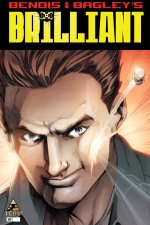Fiction that tries to answer the "what if superheroes were real" question tends to follow one of two broad approaches.* In the first, ordinary people put on costumes and try to act like superheroes despite an absence of superpowers or impossible blend of skill sets. This happens to have some currency due to the activities of Real-life Superheroes. But with all due respect to Phoenix Jones and his ilk, only the second approach piques my inner scientist. Those are the stories that speculate on the real-world possibility of metahumans. Sure it might be interesting to explore what motivates mere mortals to fight crime. But without the powers or ludicrous training, they're still basically vigilantes who cosplay. Another advantage of the latter approach is that the protagonist doesn't have to conform to the narrow requirements of the superhero genre. After all, just because someone can fly, it doesn't make her morally obligated to fight crime.
Brian Michael Bendis and Mark Bagley's creator-owned series Brilliant uses the latter. It follows a bunch of ordinary, if very smart, college students researching the possibility of developing real-world superpowers. Since Bendis and Bagley were the original creative team behind the Ultimate Spider-Man, familiar readers might expect them to bring their particular brand of teen drama into this project. They do, but unfortunately, this inaugural issue ends up showcasing the weaknesses to their Marvel-honed style.
The comic begins with a young man named Amadeus robbing a bank in broad daylight. During the heist, he exhibits a number of paranormal abilities. But just as things are about to get interesting, the scene suddenly shifts. Now another man named Albert is entering what appears to be a college dorm. He's welcomed back by the other residents, as he took the previous semester off. What follows is twenty pages of Bendis' staccato dialogue. We're treated to gems like this:
I'm OK. It's all okay.And so on and on. I get the impression that Bendis is trying hard to capture the nervous energy of the college milieu. Such cryptic shorthand might convey the casual intimacy between freinds, but it doesn't leave much room for adequate characterization. There are about half a dozen characters being introduced, including Amadeus and Albert, but they share one personality between them. Only Bagley's and Joe Rubinstein's art allows the reader to separate their individual voices. To their credit, the multi-ethnic cast is easily distinguishable. But without colorful costumes, fight scenes, and requisite poses to work from, the art only rates slightly above average. It's only towards the end when the conversation gets around to discussing the viability of creating genuine superpowers. And the scene cuts off again. There's no cliffhanger or natural chapter break.
No, really?
Really.
Did they talk to you yet?
About what?
So that's it. Two disjointed scenes with not much to latch onto. I realize it's now common practice to use the first issue as a setup for a larger story arc. But even by those standards, this is a pretty slow intro. Actually, it feels more like the prelude to the intro proper. It's a frustrating read, and not the most compelling way to hook skeptical readers.
____
* The seminal Watchmen naturally uses both.






























